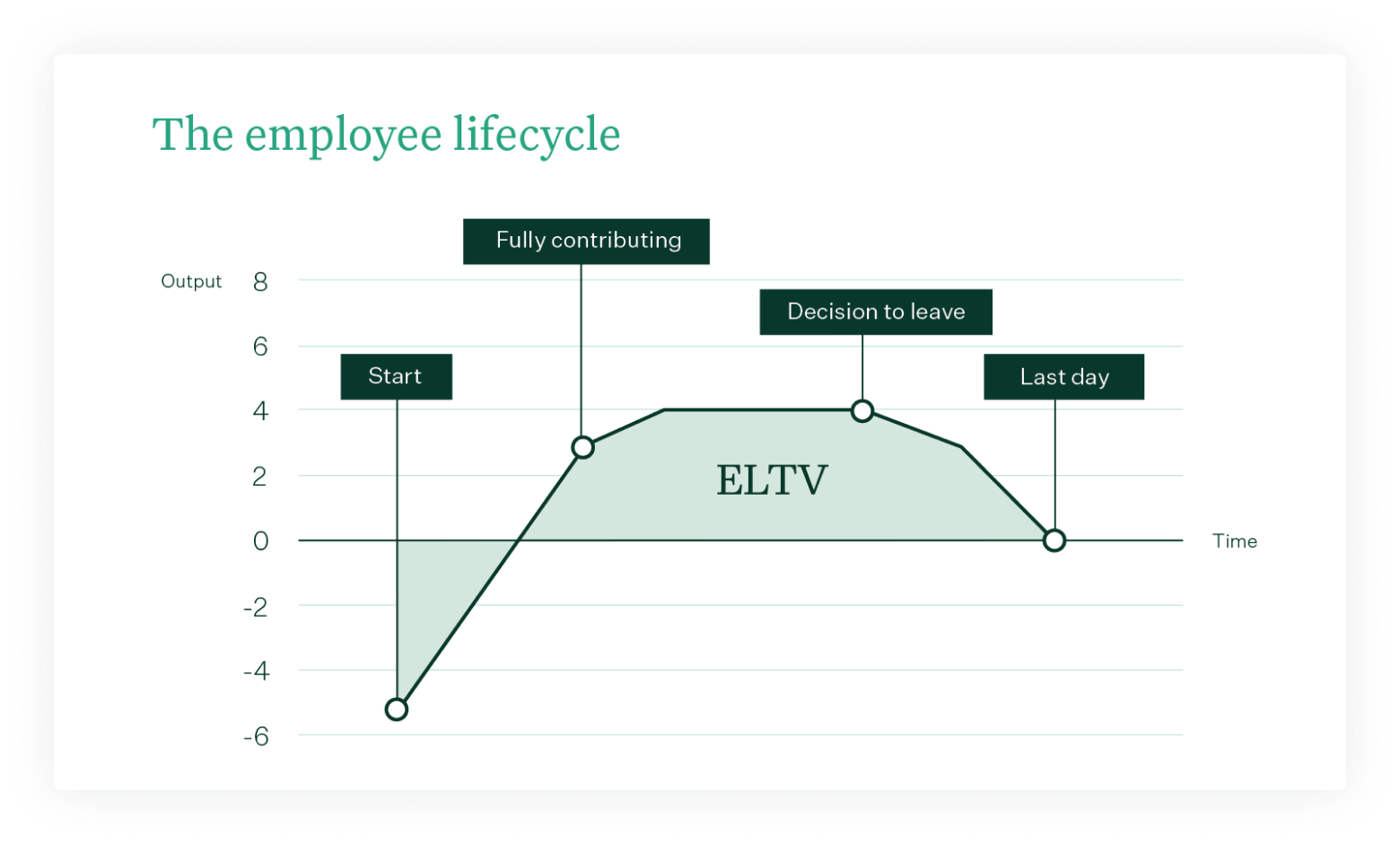The impact of people operations on employee lifetime value

9 mins, 39 secs read time
People teams sometimes find it challenging to communicate the value of their work or to be considered true business partners by their executives. That’s why our VP of People & Strategy Maia Josebachvili began writing and speaking on the topic of Employee Lifetime Value (ELTV). In this series, we’ll be sharing how the People team at Greenhouse considers the work that they’re doing in relation to ELTV and share a few tips on how you can think about your own work through this lens.
At Greenhouse, our People department consists of Talent Acquisition, People Operations, Employee Experience, and Talent Management. In this post, former Director of People Operations Jessica Pfisterer shares the impact her team’s work can have on ELTV.
People operations at Greenhouse
The People Operations team at Greenhouse is responsible for Total Rewards (compensation, benefits, and perks), employee-facing systems and operations, HR programs, and compliance. The employee is our customer, and we work to make it easy to be a Greenhouse employee. We work closely with other internal service organizations, like the Talent Management, Employee Experience (EX), and IT teams.
In this post, I’m going to talk about Total Rewards and their impact on ELTV.
I’ll start with a quick overview of the concept of ELTV
I’ll define each piece of Greenhouse’s Total Rewards package and its impact on ELTV
I’ll give you tips on designing your own Total Rewards package
I’ll provide insight on how we measure success and communicate our programs
What is ELTV?
Greenhouse’s VP of People, Maia Josebachvili, goes in depth on ELTV in her white paper on how to understand the ROI on investing in People. In short, we can use ELTV as a tool to illustrate that investing time and resources at various points in an employee’s lifecycle creates measurable and significant returns for the organization.
The graph below presents ELTV in terms of the employee lifecycle, with time on the X-axis, “output” on the Y-axis, and four points representing a few of the more obvious inflection points in an employee’s lifecycle. When we talk about ELTV, we’re talking about the area under this curve.

Worth noting: We don’t calculate ELTV as a hard number at Greenhouse because: a) there are too many variables to be able to quantify “output” effectively, even for salespeople, and b) it’s not necessary.
Instead, we take measurements at various inflection points along the curve—e.g., the point at which someone is fully ramped—and then work to move that point, e.g., ramp people better/faster. When we move the inflection point in the right direction, we increase the area under the curve. By demonstrating how much incremental ELTV is created by the movement of the inflection point, we can demonstrate the return on the investment of time and resources.
Total rewards and ELTV
One of the biggest spending categories in an organization’s budget is the cost of employee Total Rewards. I think of Total Rewards as everything the company gives the employee that can be assigned a monetary value. This includes the obvious things, like salary, stock options, and health benefits, but also includes less obvious things like New Parent Care Packages, or special equipment for your desk setup.
Total rewards has a big impact on several inflection points on the ELTV curve.
1. Hiring
First, as recruiters will tell you, an employee’s decision to join your company can be heavily influenced by the Total Rewards package you offer compared to your talent competitors. So your work can have a big impact on whether someone starts their journey with your company at all, and then continues through various touch points that impact an individual’s ELTV.
2. Retention
Once you hire an employee, the Total Rewards package then impacts how long they choose to stay. The worst thing Total Rewards can do is become a detractor. If an employee is worrying about their compensation, they are likely feeling undervalued and even more likely not doing their best work. This is bad news for the employee and for the organization.
Cash, benefits and perks
Cash compensation
What is it?
All the money we give our employees in exchange for their work. Cash compensation includes annual salaries, hourly rates, commission payments, and bonuses.
Impact on ELTV
At Greenhouse, we believe that paying people fairly for the work they do is paramount. We define fair compensation as “competitive to market, with mitigated bias, and meaningfully related to performance.” In order to ensure we’re competitive, we review market data for each new role we open, each promotion we make, and annually for the entire staff. We communicate our process to employees so they know how decisions are made and, more importantly, so that they feel that compensation decisions are fair, clear, and logical. We think that employees who feel their compensation is fair are happier and more engaged.
Tips for doing it at your company
To design a really solid cash compensation program, I recommend getting your hands on market data from companies that are as similar to you as possible, or companies with whom you know you are competing for talent. You will likely need to pay for this data, but we think it’s a worthwhile investment for Greenhouse to be able to share our compensation philosophy with our employees and feel confident in our decisions around comp. There are many good sources out there. We use Advanced-HR, and have worked with Connery Consulting in the past as well.
For new hires, we set pay bands before we open the role. I strongly recommend doing this for every new role, and every 6–9 months for roles you hire regularly. This accomplishes three things: 1) anchors us to the market, 2) avoids rewarding folks for good negotiating skills, and 3) avoids using past salary as a basis for compensation. This is particularly helpful in preventing wage inequality for women and minorities, two groups that are often negatively impacted by rewarding good negotiators or basing pay on a prior salary.
Benefits and Perks
What are they?
Benefits are the plans we provide our employees to take care of their physical and financial health. Benefits include health care plans, retirement plans, and tax-advantaged savings and spending accounts.
Perks are everything else! With the exception of stock options (discussed below), perks include anything and everything from leave programs to food to gym discounts.
Impact on ELTV
The People Ops team mission statement includes the phrase “we make it easy to be a Greenhouse employee.” Stressing about how to enroll in benefits or worrying about what’s covered in your benefits plan is a distraction from being able to do your best work—which means you end up with less engaged staff as a result. It’s important to over-communicate and provide as high a touch as possible, whether you’re administering benefits in house, using a broker, or outsourcing it altogether.
Some examples of how we communicate our benefits at Greenhouse:
Office hours with the People Ops team during Open Enrollment
Onsite presentations and Q&As; with reps from health insurance companies
Publishing all benefits info on The Hub, our internal info-sharing resource
Using Slack to automate responses to common questions and direct employees to the relevant benefits information
Having a robust perks program that focuses on meaningful, high-impact perks can make employees feel that the company is invested in them. The perks we have at Greenhouse were designed with this in mind. Some examples of high-impact perks are our programs that provide time or other support to employees for their lives outside of work. Our Flexible Paid Time Off, Paid Parental Leave, and Childcare Stipend were designed to give employees support for their whole lives. Similarly, switching to healthy foods in the office and providing funding for group activities promote wellness and help employees feel healthy and supported.
Tips for doing it at your company
Start by making sure your table stakes benefits are great and that employees understand them and can utilize them. Start with your healthcare, add tax-advantaged spending accounts (HSA, FSA), provide a low-fee 401K option, then build on from there. You can accomplish a lot using programs like PTO or Paid Parental Leave that make employees feel that they’re supported. Once you’ve rolled out new programs or upgraded existing ones, communicate them to employees in as many channels as you have.
When you’re ready to do more, make sure you’re thinking about perks from a goals-based perspective. What do you want your perks to accomplish? For example, one of the goals of our perks program is to foster friendships amongst coworkers, which is where our funding of #GHafterhours came from. Seeing this written out will help make sure that you’re allocating your resources accordingly.
Stock Options
What are they?
Stock options are one of the least tangible forms of compensation in the Total Rewards package at a private company, but have the potential to be the most motivating. The reason most companies give stock options is to align incentives for employees and the company. The idea is—if we all own part of the company, we all work hard and execute well, then we all benefit from it.
Impact on ELTV
Stock options can have a special impact on ELTV because they vest over time, meaning continued hard work and success is critical to any one employee seeing value in the future. The most critical piece of a stock option program is that employees understand what stock options are and what their potential could be. There are a lot of different ways to educate employees about stock options. At Greenhouse, we do this by providing info in one-on-one conversations and by training recruiters and managers to explain the intricacies of this type of compensation during hiring.
Measuring success
Now that I’ve shared what my team is responsible for and the potential impact our work can have on ELTV, let’s take a look at how we measure our success.
- Our semi-annual engagement survey asks employees if they feel their compensation and benefits are fair. We look at the results by department, team, and location, and if we find discrepancies or areas of concern, we make a plan to address those concerns.
- My team also monitors the frequency of questions coming through our Slack channel ticketing system, and are able to get feedback from employees on what’s working or not and make adjustments where we can.
- Additionally, we get anecdotal evidence from our Recruiting team, who talk to folks looking for roles and have a good understanding of where we might need to make adjustments to remain competitive.
Often, making adjustments means communicating more effectively. The impact that Total Rewards can have on ELTV is exponentially higher if you communicate and educate your employees on your programs. This includes any time you add, change, or expand a program. Communicate changes early and often, and think about communication channels your org uses and use all of them.
Conclusion
Total Rewards has an important impact on ELTV at the baseline. If you are designing great packages, you can attract better candidates to join your company, have more engaged employees, and increase how long they stay. Once you have programs in place, keep them competitive by measuring success and communicating them to your teams.
Want to learn more about the concept of ELTV and how to apply it at your organization? Download a copy of our ELTV eBook.